IP Mobilenet M64700G-25 700/800 Mobile Radio User Manual
IP Mobilenet, LLC 700/800 Mobile Radio Users Manual
Contents
- 1. Installation Guide
- 2. Users Manual
Users Manual

I
IP
PS
Se
er
ri
ie
es
s
M
M6
64
47
70
00
0G
G2
25
5
H
Hi
ig
gh
h
S
Sp
pe
ee
ed
d
M
Mo
ob
bi
il
le
e
R
Ra
ad
di
io
o
P
Pr
ro
od
du
uc
ct
t
O
Ow
wn
ne
er
r’
’s
s
M
Ma
an
nu
ua
al
l
Date Released: March 30, 2005
Document #: 516.80528.POM
Revision: B
Copyright 2005 IPMobileNet, Inc.
16842 Von Karman Avenue, Suite 200 Irvine, CA 92606
Voice: (949) 417-4590 Fax: (949) 417-4591
M64700G25-FCCRpt.doc Page ii
The term “IC”: before the radio certification number only signifies that Industry of Canada
technical specifications were met.
Operation is subject to the following two (2) conditions: (1) this devise may not cause
interference, and (2) this device must accept any interference, including interference that may
cause undesired operation of this device.
The following U.S. Patents apply to this product:
U.S. Patent numbers 5,640,695,6,018,647,6,243,393
Information contained in this document is subject to change without notice.
All rights reserved. Reproductions, adaptations, or translation without prior written permission is
prohibited, except as allowed under copyright laws.

TABLE OF CONTENTS
M64700G25-FCCRpt.doc Page 2
SECTION 1: OVERVIEW..........................................................................................................................3
Product Description....................................................................................................................3
M64700G25 Mobile Radio Section Descriptions......................................................................3
External Features........................................................................................................................4
SECTION 2: SETUP AND CONFIGURATION METHODS .....................................................................5
High Speed Mobile Radio Setup and Configuration Method..................................................5
Mobile Radio-to-Mobile Computer Setup......................................................................... 5
SECTION 3: INSTALLATION INSTRUCITONS ......................................................................................6
Installation Overview ..................................................................................................................6
Installation Instructions..............................................................................................................8
Pre-Installation Guidelines ............................................................................................... 8
Mounting the High Speed Mobile Radio ..........................................................................9
Serial Cable Connection and Routing............................................................................10
Ethernet Setup ...............................................................................................................10
Delay Timer Installation .................................................................................................10
Carling Switch Installation (DPST Heavy Duty Toggle) .................................................12
Mobile Radio Power Supply Installation.........................................................................13
Antenna Configuration ...................................................................................................14
Measuring Return Loss ...................................................................................15
Measuring Voltage Standing Wave Ratio .......................................................15
Measuring Insertion Loss ................................................................................16
Post Installation Checklist ..............................................................................................16
Mobile Installation Layout Diagrams ......................................................................................17
Preliminary Testing and Troubleshooting..............................................................................19
Checklist of Requirement Materials ...............................................................................19
Base Station Setup for Testing ......................................................................................20
Preliminary Test Procedure and Troubleshooting ................................................................21
Confirming High Speed Mobile Radio Receiver Sensitivity ...........................................24
SECTION 4: FACTORY TEST PROCEDURE .......................................................................................25
Equipment List .........................................................................................................................25
Programming and Configuring Mobile Radio ........................................................................26
Adjustment / Alignment Procedures....................................................................................... 27
Receiver Injection...........................................................................................................27
Receiver 1
......................................................................................................................27
Receiver 2......................................................................................................................27
Transmit Data
.................................................................................................................28
Power Setting................................................................................................................. 28
Receive Data..................................................................................................................29
Final Test .......................................................................................................................29
Uplink Hardware Timing Verification..............................................................................31
Downlink Hardware Timing Verification .........................................................................33
SECTION 5: FCC LABEL.......................................................................................................................35
M64700G25 Data Transceiver FCC Label Placement ............................................................35
M64700G25 Data Transceiver FCC Label ...............................................................................35
APPENDIX A: M64700G25 CIRCUIT BOARD DIAGRAMS .................................................................36
APPENDIX B: M64700G25 TEST DATA SHEET..................................................................................37
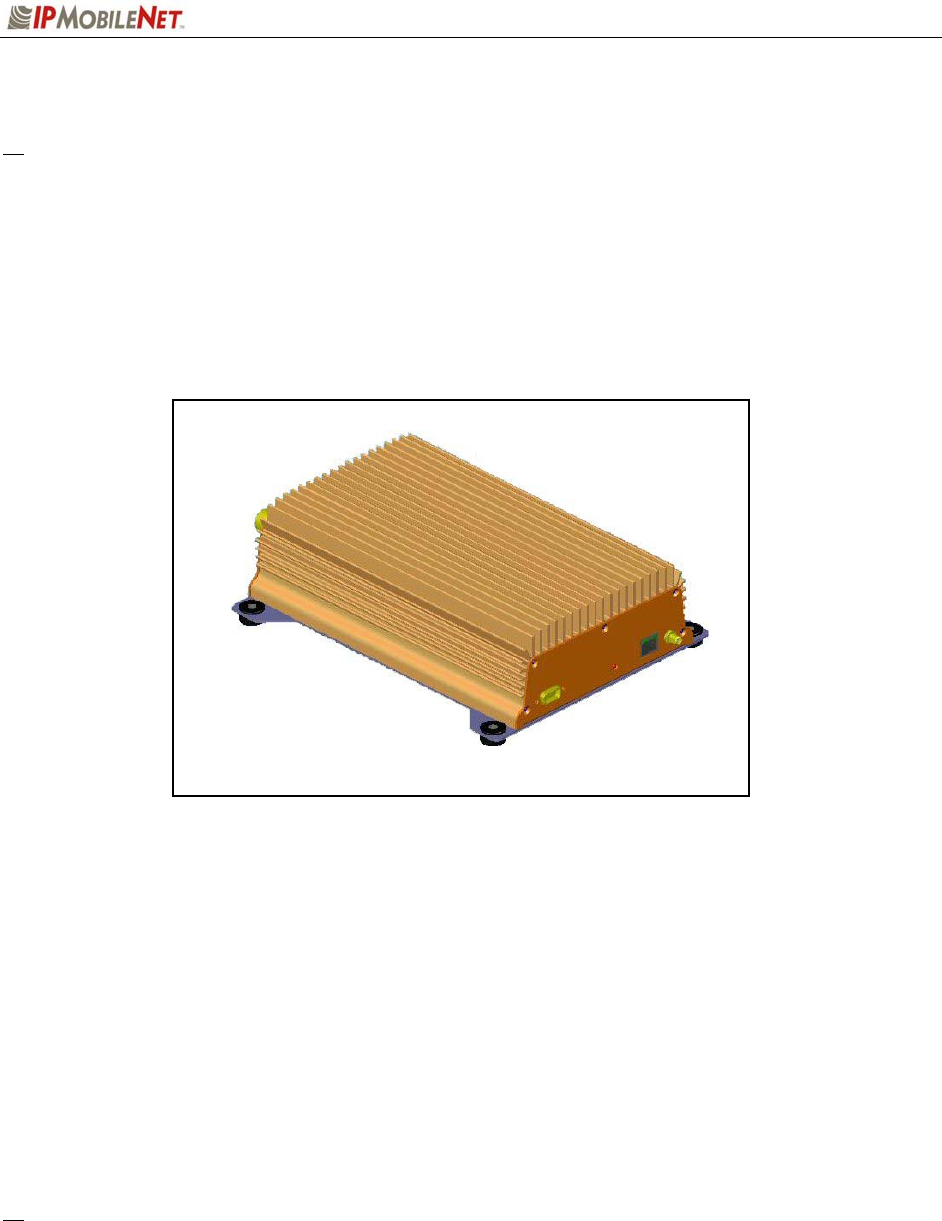
SECTION 1: OVERVIEW
M64700G25-FCCRpt.doc Page 3
Product Description
The M64700G25 Mobile Radio works within a frequency range of 794-806 MHz and requires a 1/4-wavelength
antenna.
The IPSeries High Speed Mobile Radios are intelligent devices designed for the challenging requirements
of mobile data applications. Mounted in vehicles, other intelligent devices may connect to the serial or
Ethernet ports for connectivity back to the Internet Protocol Network Controller (IPNC) and other such
servers. It provides the mobile link to land-based wired networks. The high speed mobile radio circuit
boards are built using surface mount technology (SMT) and through-hole components.
Figure 1: IPSeries High Speed Mobile Radio (Front View)
Product Functionality
The high speed mobile radio utilizes a high-performance, 32-level QAM. Further it uses state-of-the-art
OFDM technique. This new technique will enable the high speed mobile radio to transmit and receive
more than 100 Kbps data in a 25 kHz band. The high speed mobile radio features low power
consumption, high performance integrated GPS receiver. Embedding this technology in the mobile radio
lowers the cost of acquiring GPS data from vehicles and ensures optimal performance.
The high speed mobile radio technology includes Diversity Reception (DR) capability. DR reduces the
effects of fades in a multi-path environment. With the use of two (2) antennas mounted at a calculated
distance on the roof of the vehicle the Diversity Reception System (DRS) minimizes the effects of fading
by intelligently selecting the receiver with a better signal.
Diversity is most effective when the vehicle is in motion.

SECTION 1: OVERVIEW
M64700G25-FCCRpt.doc Page 4
External Features
As seen in Figure 2 below, the IPSeries High Speed Mobile Radio technology is enclosed in a compact
and sturdy aluminum case. The external features consist of a series of connectors and ports as
described in this section.
a The product warranty becomes void if an uncertified or unauthorized individual removes the
mobile radio cover.
Figure 2: IPSeries High Speed Mobile Radio (External Features)
The high speed mobile radio external features consist of the following connectors and ports:
TABLE 1: EXTERNAL FEATURES
FEATURE DESCRIPTION
TX/RX1 Transmitter / Receiver 1 antenna connection
RX2 Receiver 2 antenna connection
Power Connector 13.8 VDC high speed mobile radio power connector
Lock LED Unit ‘Ready’ Status Indicator LED (light emitting diode)
GPS GPS antenna (SMA) connector
Serial Port RS232 Serial Line Internet Protocol (SLIP) interface port
Ethernet Port 10 Base T Ethernet interface port
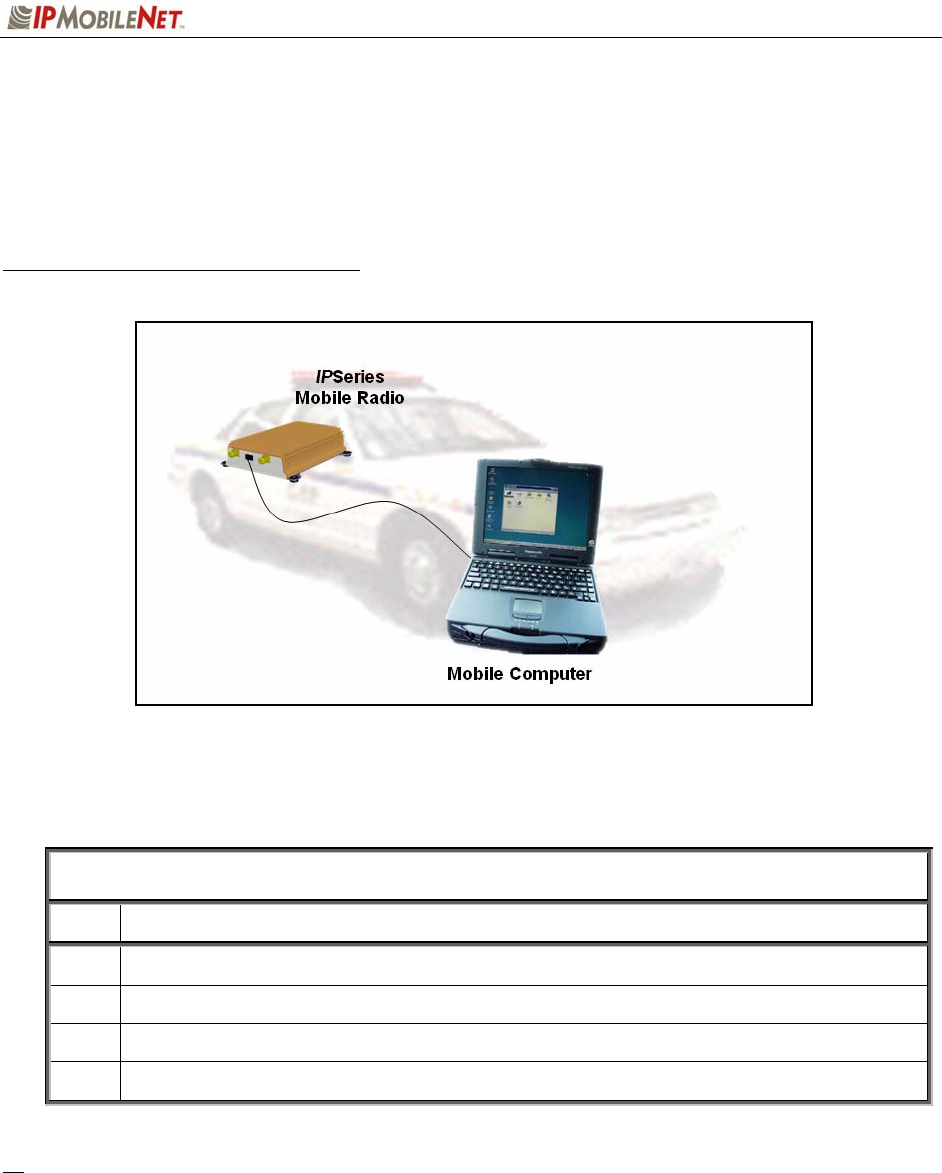
SECTION 2: SETUP AND CONFIGURATION METHOD
M64700G25-FCCRpt.doc Page 5
Mobile Radio-to-Mobile Computer Setup and Configuration
The following section describes the setup and configuration method for the high speed mobile radio in a
vehicle.
Mobile Radio-to-Mobile Computer Setup
Figure 3: High Speed Mobile Radio-to-Mobile Computer Setup
Additional components are required to setup a high speed mobile radio-to-mobile computer configuration,
and are listed below in Table 2:
TABLE 2: HIGH SPEED MOBILE RADIO-TO-MOBLE COMPUTER COMPONENTS
REQUIRED FOR INSTALLATION
QTY DESCRIPTION
1 IPSeries High Speed Mobile Radio
1 Mobile Computer
1 20-foot serial cable (DB9F – DB9M)
1 IPMobileNet SLIP Port Driver Installation Diskette (SLIP2IPMN.exe)
If using the high speed mobile radio’s Ethernet feature an Ethernet crossover cable is required to
replace the 20-foot serial cable.
To configure the high speed mobile radio and computer for this type of setup, follow the
instructions on pages 2 through 17 in the Mobile Computer Setup for Communication with the
Mobile Radio Installation Guide (IPMN p/n: 516.80310.IG) available on the Product
Documentation CD.

SECTION 3: INSTALLATION INSTRUCTIONS
M64700G25-FCCRpt.doc Page 6
Installation Overview
This chapter provides the basic steps involved in the installation process of an IPSeries High Speed
Mobile Radio into a vehicle. This chapter includes wire routing and connections between the high speed
mobile radio, other components, and the vehicle’s power.
a To prevent personal injury and vehicle damage, exercise extreme caution throughout the
installation process and follow the reminders listed below.
Follow safety precautions for handling wiring, tools, and a vehicle’s engine.
Handle the vehicle’s battery with extreme caution to avoid burns.
Do not alter the components listed in the Installation Requirements section below, unless
substitutions are noted within this chapter.
Once the antennas are installed, as directed within this user manual, all persons must
maintain a distance of no less than 39 inches from the antennas while the high speed mobile
radio is in the transmit mode.
Installation Requirements
Table 3 lists the documents required to successfully install the high speed mobile radio and connect to
the various components within the vehicle:
TABLE 3: DOCUMENTS REQUIRED FOR HIGH SPEED MOBILE RADIO INSTALLATION
DESCRIPTION PART NUMBER
The following documents are available on the Product Documentation CD
enclosed in the shipment with the high speed mobile radio: 480.0001.001
M64700G25 High Speed Mobile Radio Product Owner’s Manual 516.80528.POM
Installation Guide for Mobile Computer Setup for Communication with
the Mobile Radio 516.80310.IG

SECTION 3: INSTALLATION INSTRUCTIONS
M64700G25-FCCRpt.doc Page 7
Table 4 lists the components required to perform a successful high speed mobile radio installation and
are available for purchase through IPMobileNet, Inc.
TABLE 4: MOBILE INSTALLATION ACCESSORIES KIT
QTY DESCRIPTION IPMN PART NUMBER
4 Screws, Self Tapping #10 X 5/8 37040010-10
1 EMI Filter 127.0020.002
1 Timer, 2 hours 150.0127.004
1 Relay 128.0117.001
1 Relay Socket 128.0116.001
2 Butt Connectors #8 AWG 120.0256.001
1 Terminal, Ring #8 AWG, #10 Screw Insulated 120.0127.001
4 Terminal, Ring #18-22 AWG, #10 Screws Insulated 120.0250.004
4 Terminal, Ring #10-12 AWG, #10 Screws Insulated 120.0250.005
4 Terminal, Disconnect #14-16 F 120.0244.002
18 Terminal, Disconnect #10-12 F 120.0244.003
2 Disconnect Tab, Quad Male 200.1377.001
1 Wire, 12 AWG Black, order 5 ft. 156.0242.001
1 Wire, 12 AWG Red, order 44 ft. 156.0242.003
1 Fuse, 15 AMPS ATO 122.0042.003
2 Fuse, 30 AMPS ATO 122.0042.001
3 Fuse Holder, 12 AWG 120.0253.001
1 Switch, Toggle DPST 144.0136.001
1 Diagram, Mobile Installation (included in this manual) 502.80259.52
1 Diagram, Diversity Antenna Mobile Installation Detail (Typical Install) DT450-10-0201
Table 5 lists the auxiliary equipment required to complete the installation process.
TABLE 5: AUXILIARY EQUIPMENT
QTY DESCRIPTION IPMN PART NUMBER
1 Serial Cable (DB9MF), 20 ft. 156.0245.020
1 Wire, 8 (133/29) AWG VW-1 Red, by foot, order 19.5 ft. 156.0243.003
1 Wire, 8 (133/29) AWG VW-1 Black, by foot, order 19.5 ft. 156.0243.001
2 RG8X Cable and Mount, 800 MHz, 17 ft. (incl ¾“ Brass Mount & N
Male Crimp) 102.0200.002
2 Antenna, Radome type, 806-866 MHz, 3dB Gain (requires 1 MB8XN
for ea antenna) 102.0207.001
2 Antenna, Radome Type 821-896 MHz, 3dB Gain (requires 1 MB8XN
for ea antenna) 102.0207.002
2 Antenna, 5/8 Wave, 806-866 MHz, 3dB Gain (requires 1 MB8XN for
ea antenna) 102.0199.001
2 Antenna, ¼ Wave, 806-896 MHz, Unity Gain (requires 1 MB8XN for
ea antenna) 102.0204.010
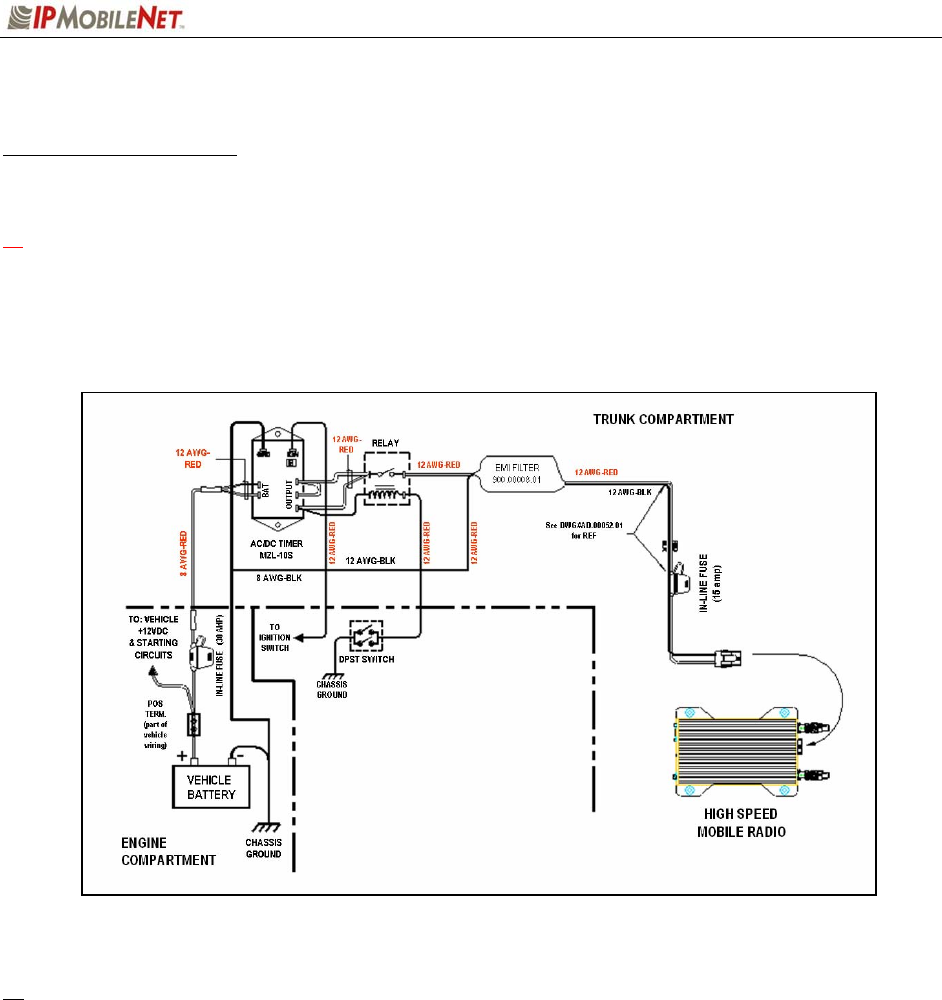
SECTION 3: INSTALLATION INSTRUCTIONS
M64700G25-FCCRpt.doc Page 8
Installation Instructions
Pre-Installation Guidelines
Prior to installing new equipment, perform the following steps:
a 1. Remove existing equipment and all related components to include stock clips on radio
wiring harness and antenna.
2. As shown in the figure below, mounting of the high speed mobile radio, delay timer, relay,
and EMI filter (noise filter) will take place in the trunk compartment, unless installing in a
vehicle without a trunk.
Figure 4: Trunk Compartment Installation
Removal of seats, rubber mats, and other obstructions from inside the driver compartment may
be necessary to facilitate routing of wires to the engine and trunk compartments.
3. To ensure appropriate cable and wire routing, exercise the following precautions:
Route cables away from sharp edges that can penetrate cable insulation and damage
wires.
Protect wires with silicone rubber grommets when routing through the engine
compartment firewall or through other holes with sharp edges.
Use high-quality electrical tape when covering exposed wires in the engine
compartment.
Avoid routing cables through areas exposed to extreme heat, such as the exhaust.
Keep wires routed through the engine compartment away from hot and/or moving
parts.
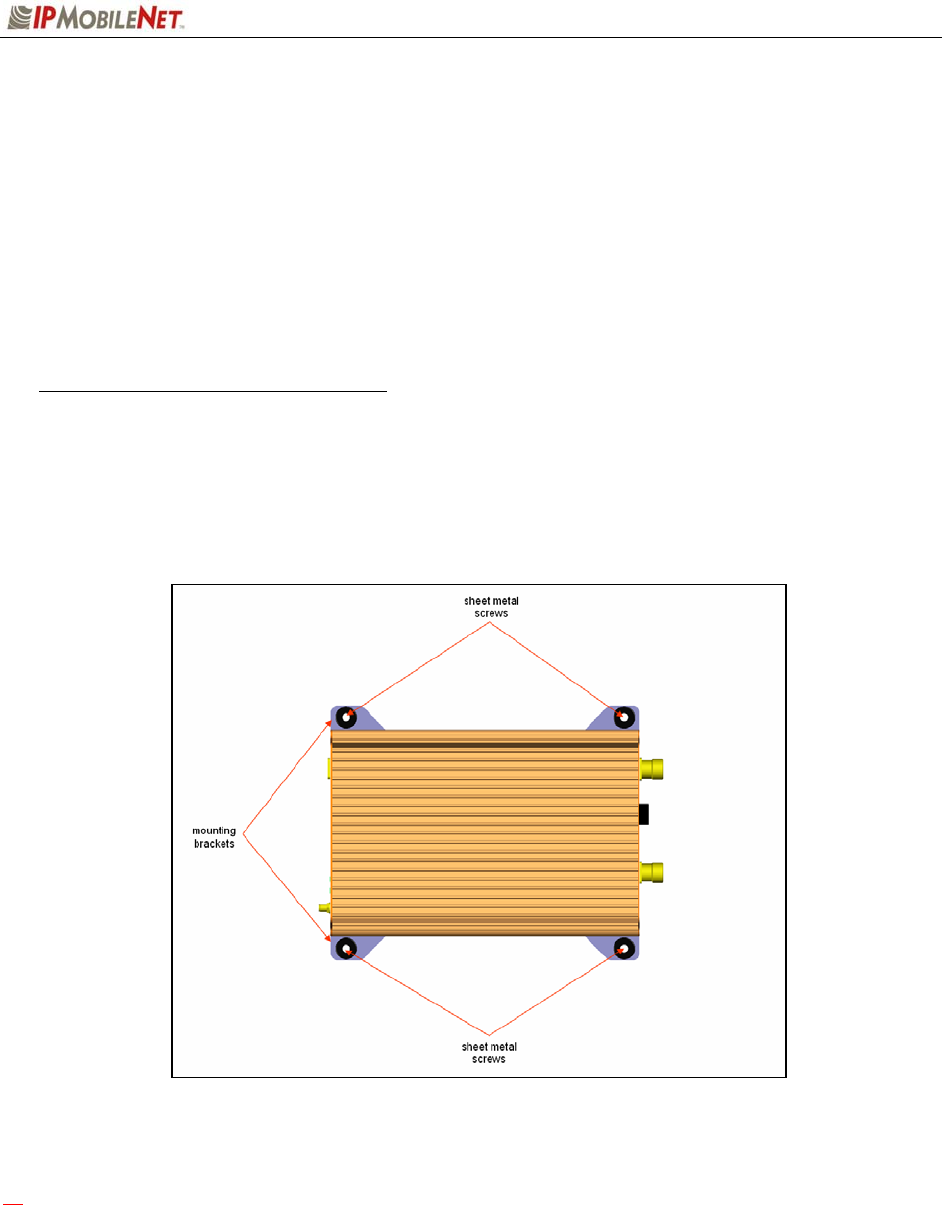
SECTION 3: INSTALLATION INSTRUCTIONS
M64700G25-FCCRpt.doc Page 9
4. Prior to drilling holes in the engine compartment firewall, inspect both sides to avoid
obstructions.
5. For grounding point, use the engine block or the negative (-) terminal of the vehicle battery.
Ground connection surfaces must be free of paint, rust, and other corrosion to maximize
performance and avoid damage. Do not tie to the vehicle chassis.
6. To simplify troubleshooting problems, label all connecting points and wires.
Mounting the High Speed Mobile Radio
To mount the high speed mobile radio, perform the following steps:
Step 1 As shown in the figure below, secure the high speed mobile radio into the trunk
compartment. Insert four (4) sheet metal screws in the high speed mobile radio
brackets.
Figure 5: High Speed Mobile Radio Mounting
a If less than four (4) screws are used, the high speed mobile radio can become loose in the trunk
compartment. This may cause the high speed mobile radio not to function properly.
When inserting screws, be careful not to disturb the vehicle’s gas tank.
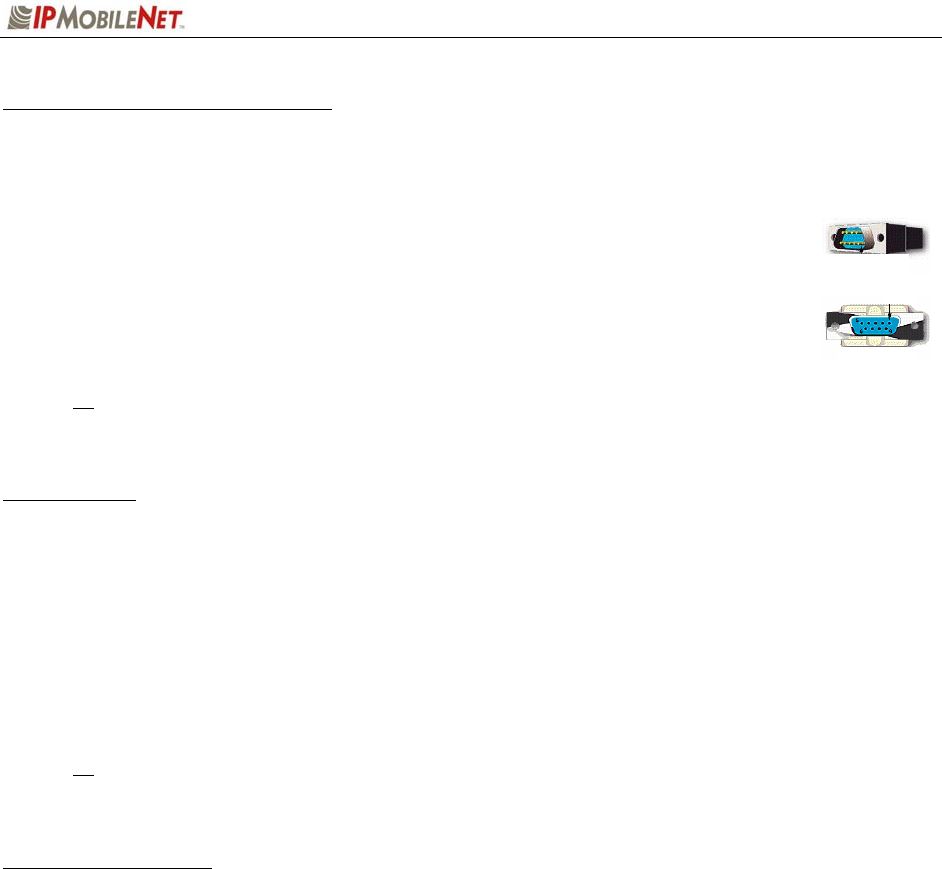
SECTION 3: INSTALLATION INSTRUCTIONS
M64700G25-FCCRpt.doc Page 10
Serial Cable Connection and Routing
The serial cable connects the mobile radio to the mobile computer located in the driver compartment.
To connect the serial cable, perform the following steps:
Step 1 Attach the 20-foot serial cable male connector (DB9M – see Figure 6)
to the mobile radio.
Step 2 Route the female connector (DB9F – see Figure 7) to the driver
compartment and connect to the serial port located on the rear of the
mobile computer.
Route the serial cable to minimize foot pressure and other potential stresses. Use split
loom tubing and nylon cable ties for cable protection.
Ethernet Setup
The user also has the option to connect the mobile radio and the mobile computer via Ethernet.
To connect the Ethernet crossover cable, perform the following steps:
Step 1 Attach the Ethernet crossover cable (minimum 20 feet) to the Ethernet port on the rear
of the mobile radio.
Step 2 Route the other end of the Ethernet crossover cable to the driver compartment and
connect to the Ethernet port located on the rear of the mobile computer.
Route the cable to minimize foot pressure and other potential stresses. Use split loom
tubing and nylon cable ties for cable protection.
Delay Timer Installation
To install the Delay Timer, perform the following steps:
Step 1 Secure Delay Timer to the trunk compartment of the vehicle inserting screws in the
appropriate locations using care not to puncture the vehicle’s gas tank.
Step 2 Route the black wire (#12 AWG) from ground connection on the Delay Timer to the
vehicle chassis (see Figure 9).
Step 3 Route and wire the red wire (#8 AWG) from the positive (+) terminal connection on
the vehicle battery connection via the in-line fuse toward the battery connection on
the Delay Timer.
Connect the red wire (#8 AWG) to the two red wires (#12 AWG). Route and wire the
red (#12 AWG) wires to the two (2) battery connections on the Delay Timer.
Figure 6
Figure 7
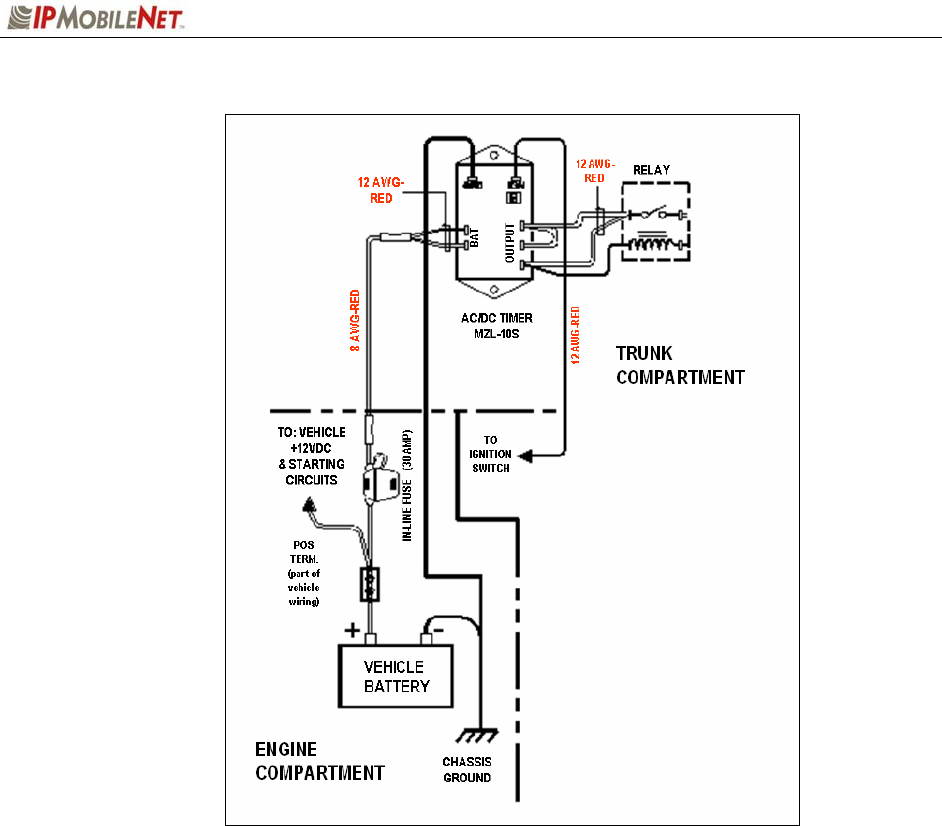
SECTION 3: INSTALLATION INSTRUCTIONS
M64700G25-FCCRpt.doc Page 11
Figure 8: Delay Timer Installation
Step 4 Route a red wire (#12 AWG) from the ignition connection on the Delay Timer to the
ignition switch in the driver compartment (see the figure above). The ignition wire
should be fused with 2A fuse.
Step 5 Route a red wire (#12 AWG) from the first and last output connections on the Delay
Timer to the Automotive Power Relay.
Step 6 Route and wire a red (#12 AWG) wire from the second output connection on the
Delay Timer to the last output connection on the Delay Timer.
Step 7 Route and wire a red (#12 AWG) wire from the last output connection on the Delay
Timer to the Automotive Power Relay coil at the position shown in the figure above.
Step 8 Route and wire a black (#8 AWG) wire from the junction (negative battery post
group) in the trunk compartment to the negative (-) terminal on the vehicle battery.
Step 9 Wire the red (#12 AWG) wire to the battery input on the Delay Timer and route the
black (#8 AWG) portion of the wire to the positive terminal on the battery via an in-
line fuse (30 AMP).
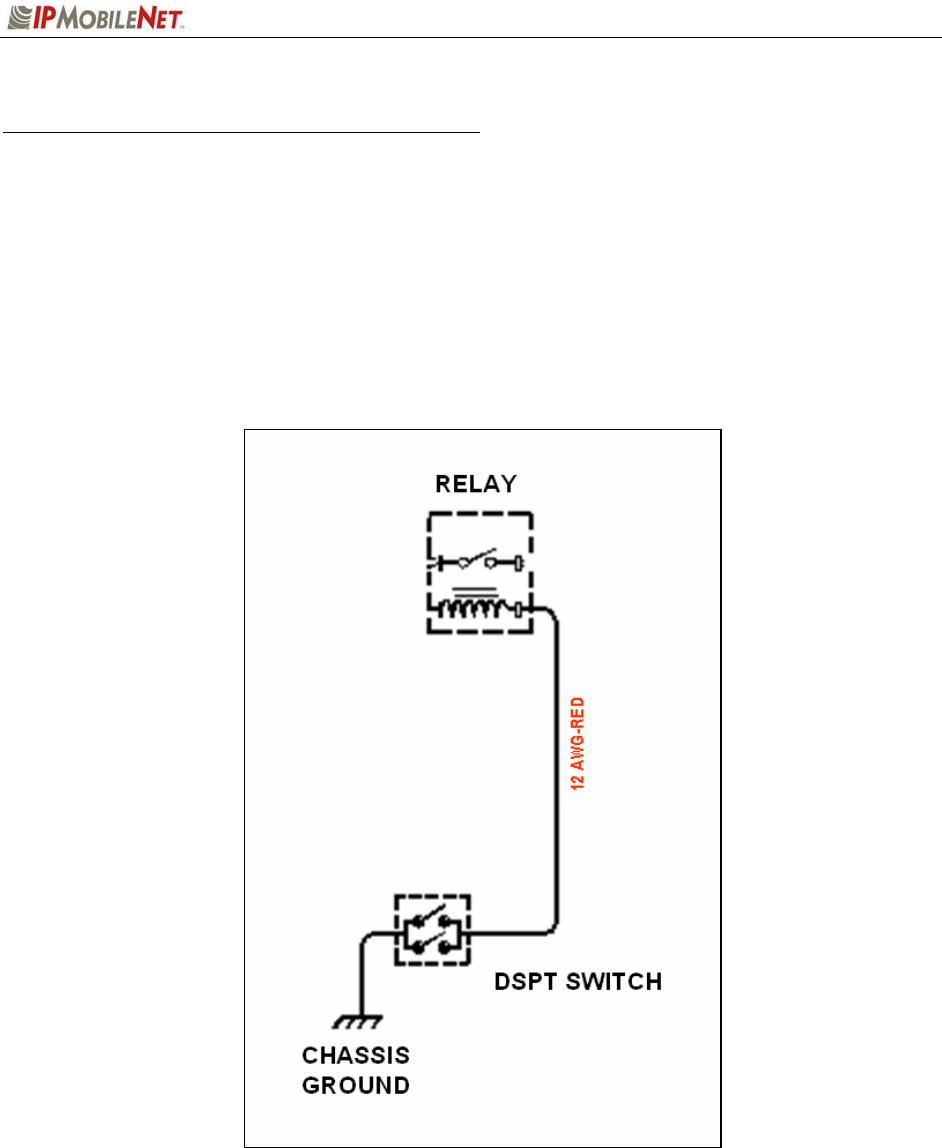
SECTION 3: INSTALLATION INSTRUCTIONS
M64700G25-FCCRpt.doc Page 12
Carling Switch Installation (DPST Heavy Duty Toggle)
To install the switch, perform the following steps:
Step 1 Mount the switch in the selected location.
Step 2 Route and wire a red wire (#12 AWG) from the switch to the Automotive Power Relay
(see the figure below).
Step 3 Ground the switch by routing and wiring a black wire from the switch to the chassis
ground.
Figure 9: Carling Switch Installation
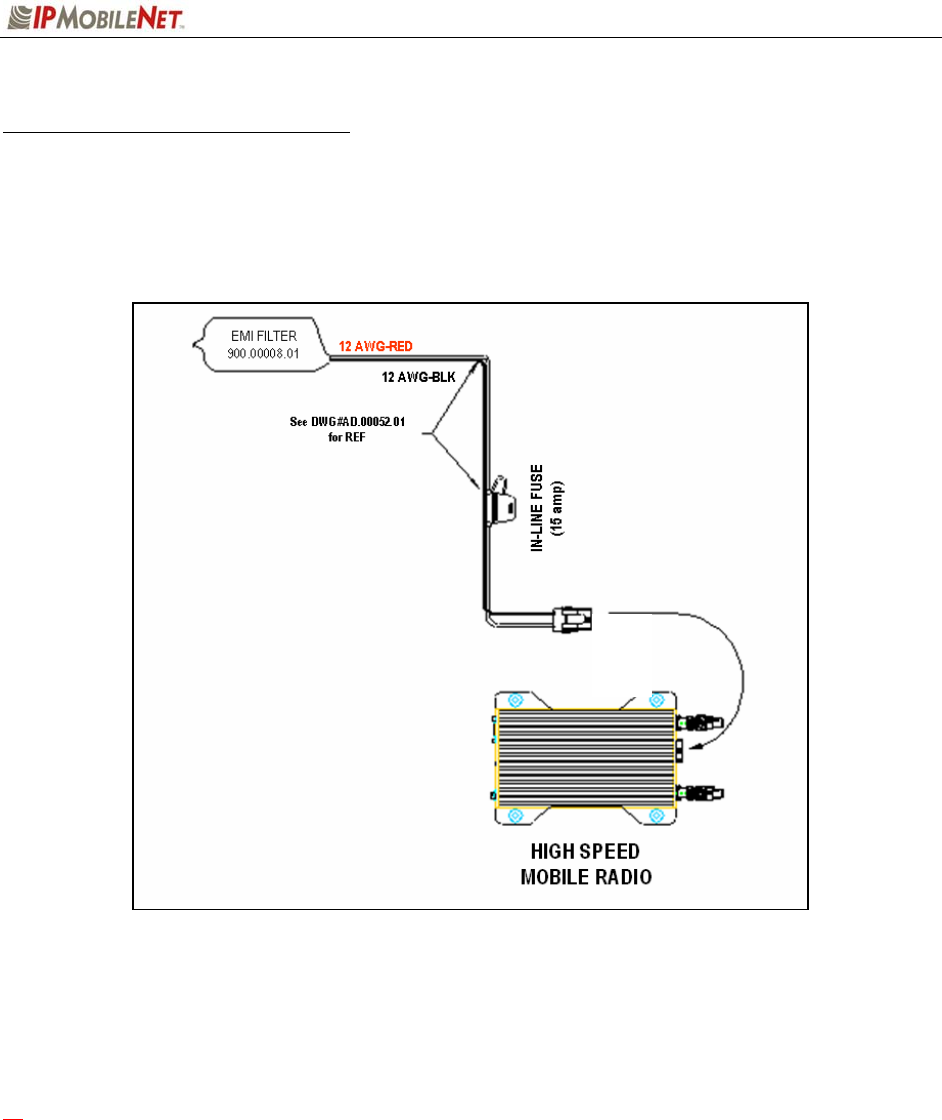
SECTION 3: INSTALLATION INSTRUCTIONS
M64700G25-FCCRpt.doc Page 13
Mobile Radio Power Supply Installation
To install the mobile radio power connection, perform the following steps:
Step 1 Route and connect the power cable to the EMI filter, as shown in the figure below.
Figure 10: Power Supply Installation
Step 2 Route and connect the other end of the power cable to the rear of the mobile radio
to the power connector (13.8 VDC) connection.
a WARNING! Do not connect power before installing and connecting proper antenna or dummy
load on the TX/RX1 port. The mobile radio must never be allowed to transmit without a suitable
output load.
Step 3 Install the GPS antenna. The GPS antenna is required for the mobile radios and
the base stations.

SECTION 3: INSTALLATION INSTRUCTIONS
M64700G25-FCCRpt.doc Page 14
Antenna Configuration
Two (2) antennas are mounted and installed on the roof of the vehicle using specific
measurements for distance.
To mount and install the antennas, perform the following steps:
Step 1 Install antennas (see the figure below).
Observe correct separation between antennas (refer to Table 7: Mobile Antenna
Distance Matrix). This table provides midpoint distance calculations and minimum and
Near-Field Exclusion Zone (NFEZ) for proper diversity reception.
a The NFEZ distance is an absolute minimum. The greater the distance between the
antennas to any other surfaces will result in improved performance.
Step 2 Cut a mounting hole in the roof of the vehicle using an electric drill or hole saw.
The antenna-mounting hole provides ground connection to the antenna. Ensure that a
metal-to-metal connection between the antenna shields exists.
Figure 11: Antenna Distance Configuration
1 2

SECTION 3: INSTALLATION INSTRUCTIONS
M64700G25-FCCRpt.doc Page 15
The previous figure represents the recommended front-to-rear antenna installation. The
receiver antenna (RX2) should be the antenna nearest to the light bar.
Step 3 All antenna mounts must be environmentally tight. Install or use O-rings to seal the
antenna base to the rooftop of the vehicle.
Step 4 Route the coaxial cables to the mobile radio through one of the hollow spaces in the
roof supports into the trunk compartment where the high speed mobile radio is
mounted.
Both antennas should be checked and tested to ensure they are functioning properly.
a If these installation guidelines are followed, it will be safe for persons to stand at a
distance no less than 39 inches from the antennas while the mobile radio is in
transmit mode.
Measuring Return Loss
The following test is performed without any power, thus can be performed immediately after the
installation of the coax and antenna, following the installation of the N-type connector on the coax.
To measure Return Loss, perform the following steps:
Step 1 Select the appropriate Antenna Analysts to perform the test.
Step 2 Connect the antenna to be tested to the Antenna Analyst.
Step 3 Turn on the Antenna Analyst and the Return Loss (RETL) is displayed in dB to the
left of the Voltage Standing Wave Ratio (VSWR) curve.
The Return Loss Specification is –14 dBm or greater (with good antennas the typical
range will be between –14 and –28).
Measuring Voltage Standing Wave Ratio
To measure the Voltage Standing Wave Ratio (VSWR) Reflected Power, perform the following
steps:
Step 1 After selecting the appropriate Analyst and connecting the antenna to be tested,
press F1 to access the Analyst Menu.
Step 2 Press F1 again to access the Display (DSPLY) menu, which lists the modes.
Step 3 Press F2 to select the VSWR display mode. Plotting will resume and the VSWR
value is highlighted.
The VSWR Reflected Power Specification should be at a ratio of approximately 1.6 to 1.

SECTION 3: INSTALLATION INSTRUCTIONS
M64700G25-FCCRpt.doc Page 16
Measuring Insertion Loss
To measure Insertion Loss of an unterminated length of coax, perform the following steps:
Step 1 Connect the antenna to be tested to the appropriate Antenna Analyst.
Step 2 Turn on the Antenna Analyst and the Return Loss is displayed in dB to the left of the
VSWR curve.
To switch from the RETL mode to VSWR mode, refer back to the previous set of
instructions.
Step 3 Divide the result by two (2).
Post Installation Checklist
Table 6 lists the tasks that should be performed upon completing installation.
TABLE 6: POST INSTALLATION CHECKLIST
NO. CHECKLIST ITEM ;
1 Scope out the entire vehicle setup to locate any obvious problem areas.
2 Check wiring for safety concerns.
3 Use tie wraps to ensure that all wires routed in parallel are bundled together.
4 Check to see if any wires are exposed.
5
If any wires are exposed, use electrical tape to cover.
When covering wires in the engine compartment, use high-quality
electrical tape.
6 Perform appropriate testing as described in this manual to ensure mobile radio
works properly.
Once installation is completed, remove all debris and restore dismantled parts and rubber mats to
appropriate locations.

SECTION 3: INSTALLATION INSTRUCTIONS
M64700G25-FCCRpt.doc Page 17
Mobile Installation Layout Diagrams
Figure 12 Vehicle Unit Wiring Interconnection Layout
Table 7 lists the high speed mobile radio antenna distances by frequency band.
TABLE 7: MOBILE ANTENNA DISTANCE MATRIX
Frequency
Band in MHz
Center
Frequency in
MHz
Antenna
Spacing for
¼ Wave Ant
(inches)
Wavelength
(inches)
Near-Field
Exclusion
Zone*
(inches)
¼ Wave
Length
(inches)
130-140 135 65.4 87.3 10.9 21.8
140-150 145 61.2 81.4 10.2 20.4
150-160 155 57.0 76.2 9.5 19.0
160-174 167 53.1 70.7 8.9 17.7
450-470 460 19.2 25.7 3.2 6.4
470-490 480 18.6 24.6 3.1 6.2
490-512 501 17.7 23.6 2.9 5.9
764-784 774 11.4 15.26 1.91 3.81
784-804 794 11.2 14.88 1.86 3.72
806-821 814 10.8 14.5 1.8 3.6
*NFEZ = Minimum Near-Field Exclusion Zone **Round antenna spacing to the nearest ⅛”
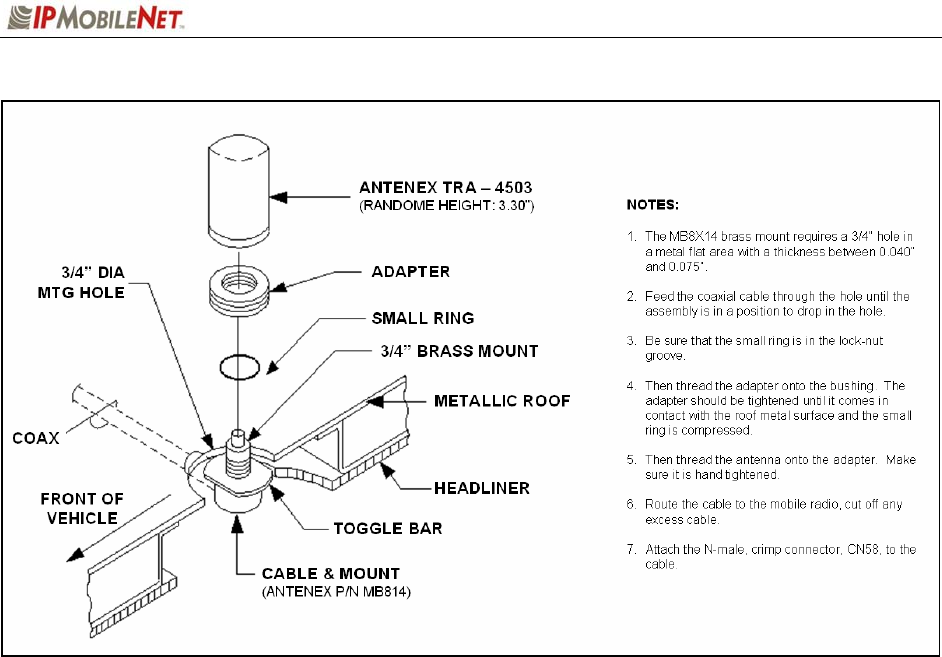
SECTION 3: INSTALLATION INSTRUCTIONS
M64700G25-FCCRpt.doc Page 18
Figure 13 Diversity Antenna Mobile Installation Detail (Typical Installation)

SECTION 3: INSTALLATION INSTRUCTIONS
M64700G25-FCCRpt.doc Page 19
Preliminary Testing and Troubleshooting
This section provides a functional preliminary test for the mobile radio once installed. It is used to
determine the condition of new mobile radios before being placed into service.
Checklist of Required Material
Table 8 provides a checklist of the tools and equipment required to perform the preliminary test
procedure.
TABLE 8: CHECKLIST OF REQUIRED MATERIAL TO PERFORM PRELIMINARY TESTING
NO. REQUIRED TOOLS/EQUIPMENT ;
1 IPSeries High Speed Mobile Radio installed in the vehicle as previously described
in this chapter
2 A laptop with an available serial communication port and Microsoft Windows 98 or
greater installed
3 IPMobileNet Dial-Up Networking and IPMessage software loaded onto the laptop
(SLIP2IPMN.exe)
4 DC power supply with ammeter, 13.8V, 12 amps or more (Astron VS12M or
equivalent)
5 Corresponding calibrated IPSeries Base Station
6 Internet Protocol Network Controller (IPNC)
7 Two antennas (generic mag mounts) tuned to frequency of transceiver
8 Serial cable DB9M – DB9F connectors (IPMN p/n: 156.0245.020)
9 RF Attenuator 10-20 dB with appropriate wattage rating for transceiver

SECTION 3: INSTALLATION INSTRUCTIONS
M64700G25-FCCRpt.doc Page 20
Base Station Setup for Testing
The system must be programmed with the customer’s parameters before any tests are made on
the mobile radio.
To prepare the base station to be used in the mobile radio test, perform the following steps:
Step 1 On the laptop at the Windows desktop, click on the Start button and select
Accessories, Communications, and HyperTerminal.
Step 2 Power up the base station.
First-time users must enter the customer’s operating parameters into the base station
with HyperTerminal (refer to the IPSeries High Speed Base Station System Manual
for instructions and the client’s system documentation for parameters).
a Ensure that the calibrated base station and the high speed mobile radio antennas are
separated by at least 10 feet. If the antennas are too close, the high speed mobile
radio receivers may overload by the transmitters resulting in intermittent
communications and high data errors.
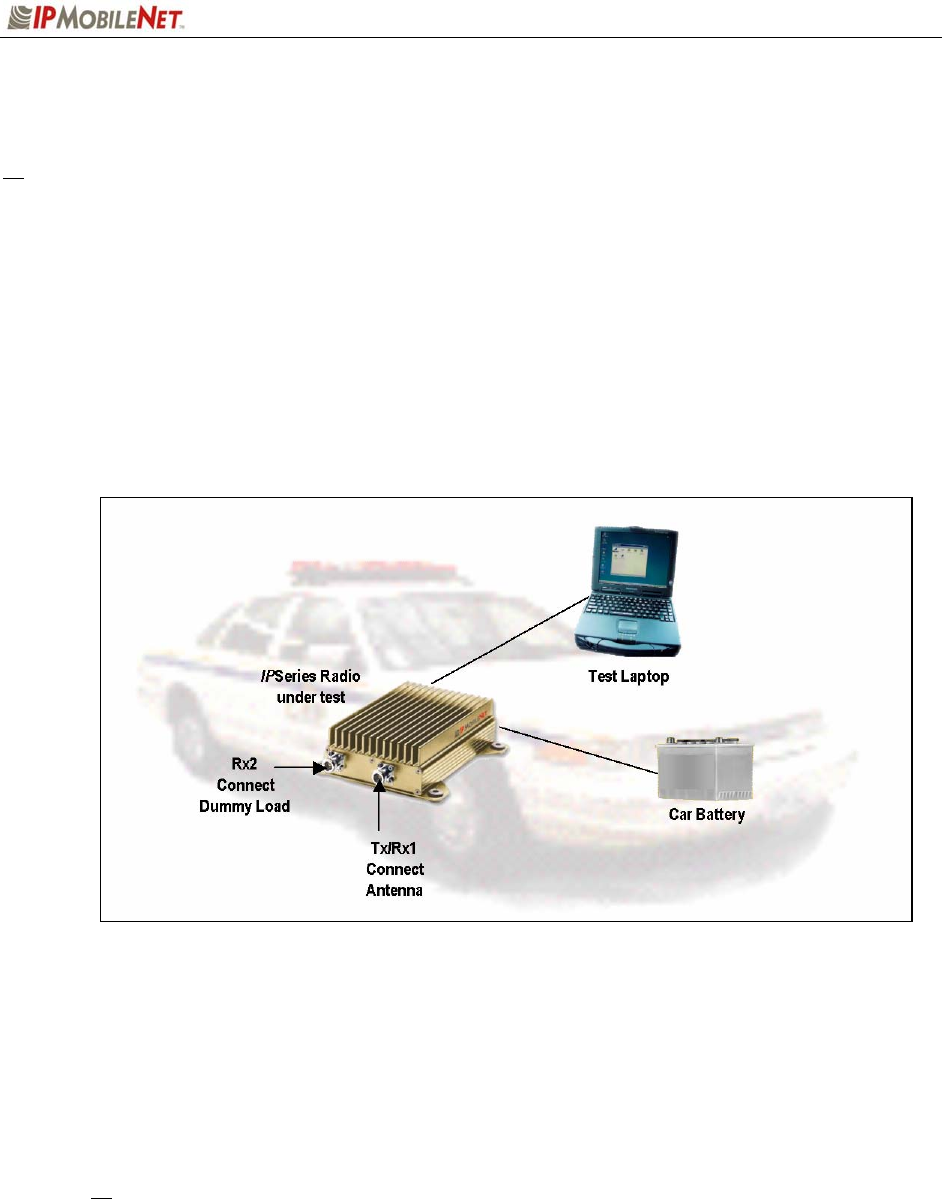
SECTION 3: INSTALLATION INSTRUCTIONS
M64700G25-FCCRpt.doc Page 21
Preliminary Test Procedure and Troubleshooting
Prior to performing this procedure, the IPNC IP address must be known. Note taking during
preliminary testing is crucial to ensure necessary information is gathered to use for additional
testing or if the mobile radio needs to be submitted for repair.
To test mobile radio functionality, perform the following steps:
Step 1 Perform a visual inspection of the mobile radio and its connections. Validate that
all connectors and power cables are in good condition and all chassis screws are
in place.
Step 2 Connect the mobile radio as shown in the figure below.
Figure 14High Speed Mobile Radio Connection for Testing
Step 3 Power on the mobile radio and the test laptop. The power supply ammeter must
read 1.0 amp or less with a 13.8 VDC output.
Step 4 At the desktop, run the dial-up connection setup to use Serial Line Internet
Protocol (SLIP) by double clicking on the SLIP2IPMN shortcut.
The SLIP2IPMN dial-up network shortcut displays as an icon on the laptop’s desktop. If
the SLIP2IPMN shortcut is not available on the desktop, consult the Mobile Data
Computer for Communication with the Mobile Radio Installation Guide (IPMN p/n:
516-80310.IG) for instructions on how to set up the connection.
Step 5 At the desktop, run the IPMessage Utility by double clicking on the IPMsg
shortcut. The IPMessage window displays.
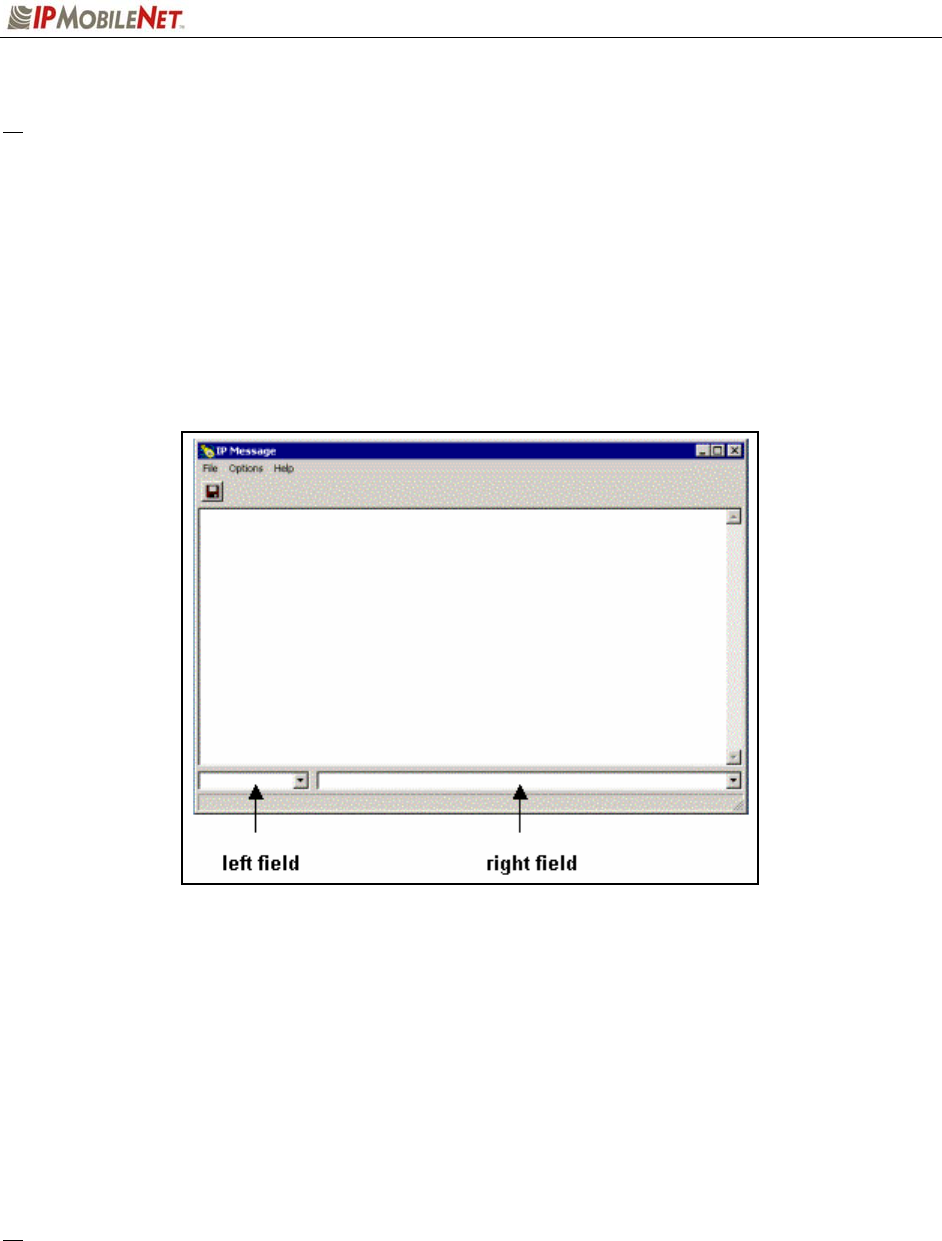
SECTION 3: INSTALLATION INSTRUCTIONS
M64700G25-FCCRpt.doc Page 22
# If a message window appears indicating the connection was unsuccessful, perform the following
troubleshooting steps:
1. Ensure the serial and power cables are properly connected.
2. Verify that the mobile radio lock LED (light emitting diode) is on, indicating the mobile radio
has power.
3. Ensure that the SLIP2IPMN dial-up connection is running.
4. If problem persists after retrying, replace the serial cable with one that is known to be
working properly.
Figure 15IPMessage Window
Step 6 In the IPMessage window in the left field, enter the mobile radio’s IP address and
press the [TAB] button. If the mobile radio IP address is not known, enter
255.255.255.255 in the left field.
Step 7 In the right field type a ? and click the [ENTER] button. A list of mobile radio
configuration parameters appears in the upper message window. This verifies
that the IP address is correct, the mobile radio’s serial interface is live, and that
the high speed mobile radio’s microcontroller section is active.
# If the upper message window only displays “To [IP address] ?”, communication has not been
established. Validate the IP address.
(
Address
)
(
Commands
)

SECTION 3: INSTALLATION INSTRUCTIONS
M64700G25-FCCRpt.doc Page 23
Step 8 At the desktop, click on the Start button and select Programs and MS-DOS
Prompt. The MS-DOS window displays.
Step 9 Ping the IPNC commanding the transmitter to send 25 messages of 500
characters each to the IPNC as well as a response through Receiver 1 back to
the laptop or desktop PC by typing in the following command at the MS-DOS
prompt replacing NNN.NNN.NNN.NNN with the IPNC IP address:
Ping NNN.NNN.NNN.NNN –n 25 –l 500 –w 4000
After entering the command, press [ENTER] to continue.
When entering a command, pay special attention to the spaces and the
characters being typed.
# If the calibrated base station does not respond, check the syntax of the Ping command and verify
the IP address is correct.
If the ping command runs but high packet loss figures are shown, perform the following:
1. Verify that the calibrated base station and mobile radio antennas are separated by at least
10 feet. If the antennas are too close, the mobile radio receivers overload by the
transmitters resulting in intermittent communication and high data errors.
2. Verify the calibrated base station parameters are correct for the mobile radio. Such
parameters include IP addresses and complementary RX/TX frequencies.
3. Check to ensure the data and power cables are connected correctly.
4. If the Ping command continues to fail, test using a mobile radio that is known to be working
properly.
Step 10 Check the test laptop and verify that the Packets Lost Percentage is zero to 1%
packet loss. Greater losses may indicate a problem with the transmitter/receiver
1, or modem circuitry.
Step 11 Change the antenna on the mobile radio to the RX2 antenna input.
Step 12 Connect the RF attenuator to the mobile radio’s TX/RX1 antenna input.
Step 13 Connect the second antenna to the RF attenuator. In the IPMessage window,
enter receiver=2. This will allow the mobile radio to only receive via Receiver 2.
Step 14 Type the following command at the MS-DOS prompt replacing
NNN.NNN.NNN.NNN with the IPNC IP address:
Ping NNN.NNN.NNN.NNN –n 25 –l 500 –w 4000
After entering the command, press [ENTER] to continue.
Step 15 Check the test laptop and verify that the Packets Lost Percentage is zero to 1%
packet loss. Greater losses may indicate a problem with the transmitter/receiver
1, or modem circuitry.

SECTION 3: INSTALLATION INSTRUCTIONS
M64700G25-FCCRpt.doc Page 24
Confirming High Speed Mobile Radio Receiver Sensitivity
This set of instructions provides the user with a list of required equipment and steps needed to confirm
mobile radio Receiver sensitivity.
Requirements
IPSeries High Speed Mobile Radio
DC power supply, 13.8V, 12 amps or more (Astron VS 12M or equivalent)
Desktop or laptop computer with IPMessage installed
Agilent HP 8920A or B Service Monitor
Serial cable DB9M – DB9F connectors (generic)
To confirm mobile radio receiver sensitivity, perform the following steps:
Step 1 Connect the mobile radio to the recommended power supply, the desktop or laptop
computer, and the service monitor.
Step 2 Turn on the mobile radio.
Step 3 Connect the serial cable or Ethernet interface to the mobile radio and the desktop or
laptop computer.
Step 4 Start the connection to the mobile radio.
Step 5 Start the IPMessage utility.
Step 6 At the IPMessage window, enter the mobile radio IP address and press [ENTER].
Step 7 At the IPMessage window, enter unlock=password (entering the assigned
password) and press [ENTER].
Step 8 Send the following test mode command at the IPMessage window, by entering
testmode=1 and press [ENTER] to continue.
Step 9 Generate an on frequency, modulated (1000 Hz @ 5 kHz dev) signal to Receiver 1 at
–100 dBm.
Step 10 At the IPMessage window, type noise and press [ENTER] to continue.
Step 11 Confirm that the noise level for Receiver 1 is +/- 2dB of the –100 dBm level.
Repeat the same steps for Receiver 2.

SECTION 4: FACTORY TEST PROCEDURE
M64700G25-FCCRpt.doc Page 25
Equipment List
The following table lists the equipment required to perform the M64700G25 Mobile Radio Factory Test
Procedure:
TABLE 9: EQUIPMENT REQUIRED TO PEREFORM FACTORY TEST PROCEDURE
QTY DESCRIPTION MANUFACTURER MODEL
2
PC’s
One for Mobile
One for Base
Windows 9X w/
IPMessage
AVR
1 Service Monitor – Communication Test Set HP HP8920B or
equivalent
1 Digital multi-meter Tektronix
Fluke 77 or equivalent
1 DC power supply w/ ammeter, 13.8V, 23 Amps or
more Astron RM35A
1 4-Channel Scope Tektronix TDS 460A
1 M64700G25 Mobile Radio
1 B32450-25 Calibrated Base Station
1 Internet Protocol Network Controller (IPNC)
1 100 watt dummy load/attenuator Pasternack PE7021-40 or
equivalent
2 UHF Antennas (generic mag mount)
1 Serial cable DB9M-DB9F connectors IPMN p/n:
156-0245-020
1 IP power cable IPMN p/n:
502-82017-52
1 3-foot RF jumper cable with type N connectors
(generic)
1 Scope test probe (generic, X1 attenuation)
1 Ceramic tuning tool IPMN p/n:
44010006
1 ea #0, #1, and #2 Phillips screwdrivers (generic)
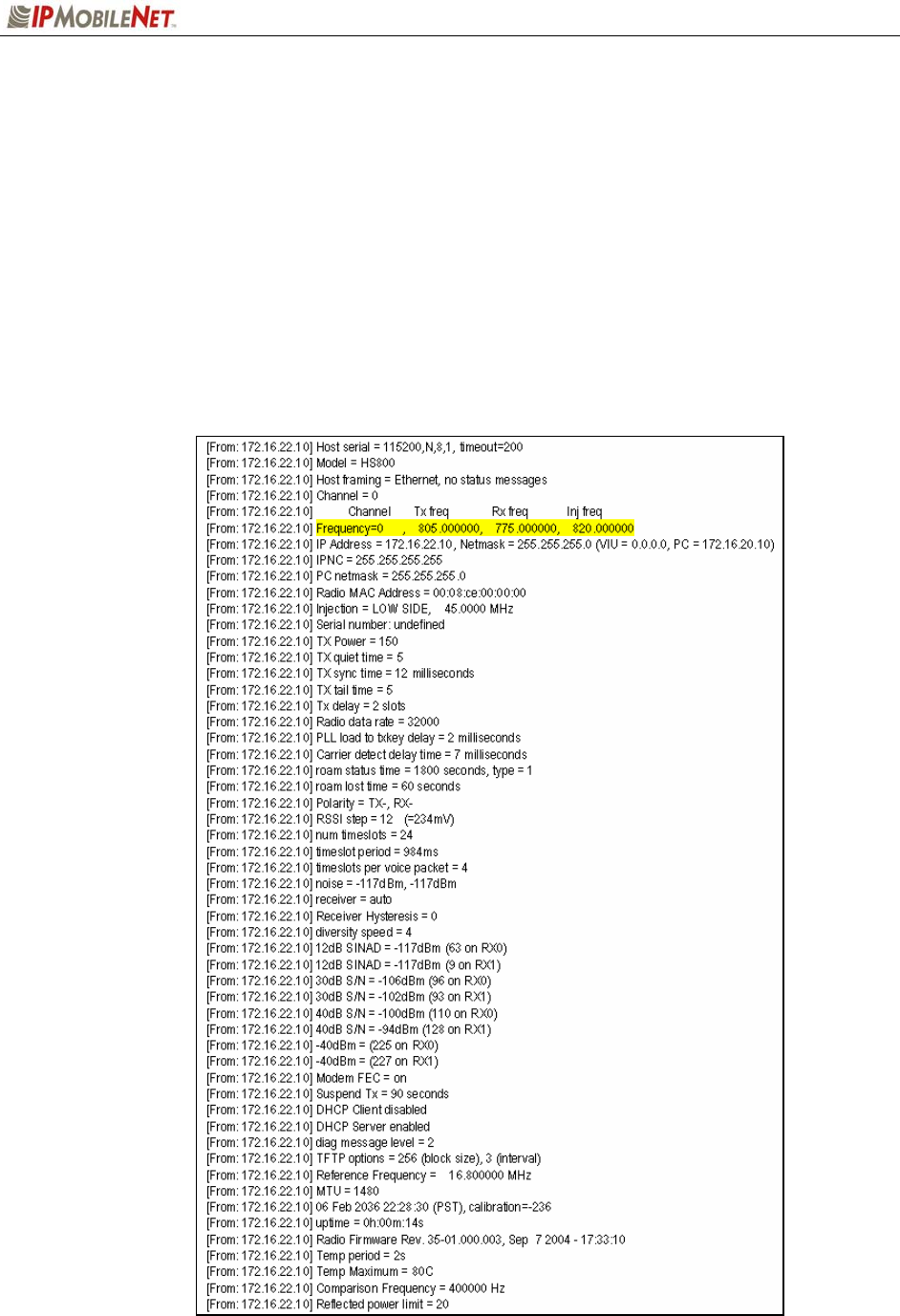
SECTION 4: FACTORY TEST PROCEDURE
M64700G25-FCCRpt.doc Page 26
Programming and Configuring Mobile Radio
Once the appropriate equipment for performing the factory test are gathered, perform the following steps
to program and configure an M64700G25 Mobile Radio:
Step 1 Enter the mobile radio serial number, date test being performed, and tester’s name on the
Test Data Sheet (see Appendix B).
Step 2 Program the radio to the current Firmware revision using the AVR programming utility.
Step 3 Connect a PC to the radio and launch the IPMessage program. In the IPMessage window,
type factory default, press [ENTER], and the radio displays the radio’s default values.
Step 4 Enter the appropriate values for the radio's frequency band. The following values were used
for a 764 to 806 MHz mobile radio:

SECTION 4: FACTORY TEST PROCEDURE
M64700G25-FCCRpt.doc Page 27
Adjustment / Alignment Procedures
Receiver Injection
Perform the following steps to adjust the receiver injection and injection frequency:
Step 1 While monitoring the receiver injection frequency at RXINJ1, input the value for the DAC
frequency control for minimum frequency error (+/- 100Hz). Record this value on the Test
Data Sheet.
Step 2 While monitoring the 44.545 MHz 2nd injection frequency at U6 pin 4, adjust trimmer
capacitor CV22 for the maximum amplitude of this injection frequency. The maximum
amplitude must be between -3 to -5 dBm. Record this value on the Test Data Sheet.
Step 3 Repeat Step 2 by monitoring U9 pin 4 and adjusting CV20 for Receiver2 IFLO. Record this
value on the Test Data Sheet.
Receiver 1
Perform the following steps to adjust receiver 1:
Step1 Inject an on-frequency carrier signal with amplitude of -80 dBm, modulated with a 1 kHz test
tone at +/- 5.0 kHz deviation into receiver 1's antenna port.
Step 2 While monitoring the voltage at RSSI1 Test Point with a DMM, adjust trimmer capacitor CV15
and C16 to midway between the points where the oscillation stops.
Step 3 While monitoring the DC level of the recovered modulation; adjust potentiometer RV6 for a
reading of 2.500 VDC +/- 1 mV DC.
Step 4 While monitoring the amplitude of the recovered audio signal, adjust potentiometer RV5 and
RV6 for a reading of 350 mV RMS and 2.500 VDC.
Step 5 Steps 3 and 4 are interactive adjustments, therefore repeat steps 3 and 4 until further
adjustment is no longer required (i.e. when 350 mV RMS and 2.500 VDC are realized).
Step 6 While monitoring the recovered audio signal at TP1, verify the distortion is less than 3%
adjust CV15 and CV16 if necessary to achieve less than 3% distortion. Record this value on
the Test Data Sheet.
Step 7 While monitoring the recovered audio signal at TP1, verify the SINAD is -118 dBm or better.
Record this value on the Test Data Sheet.
Receiver 2
Perform the following steps to adjust receiver 2:
Step 1 Inject an on-frequency carrier signal with amplitude of -80 dBm, modulated with a 1 kHz test
tone at +/- 5.0 kHz deviation into Receiver 2's antenna port.
Step 2 While monitoring the voltage at RSSI2 Test Point with a DMM, adjust trimmer capacitor CV6
and CV7 to midway between the points where the oscillation stops.

SECTION 4: FACTORY TEST PROCEDURE
M64700G25-FCCRpt.doc Page 28
Step 3 While monitoring the DC level of the recovered modulation, adjust potentiometer RV4 for a
reading of 350 mV (+/-10 mV) RMS.
Step 4 While monitoring the amplitude of the recovered audio signal, adjust potentiometer RV3 for a
reading of 2.500 (+/-10 mV) VDC.
Step 5 Steps 3 and 4 are interactive adjustments, therefore repeat steps 3 and 4 until further
adjustment is no longer required (i.e. when 350 mV RMS and 2.500 VDC are realized).
Step 6 While monitoring the recovered audio signal at TP1, verify the distortion is less than 3%,
adjust CV3 if necessary to achieve less than 3% distortion. Record this value on the Test
Data Sheet.
Step 7 While monitoring the recovered audio signal at TP1, verify the SINAD is -118 dBm or better.
Record this value on the Test Data Sheet.
Transmit Data
Perform the following steps to adjust transmit data:
Step 1 Use IPMessage to set the transmit power to 0.
Step 2 Using the x=1400,n command of IPMessage to generate transmit data messages while
observing the transmitted signal on the HP RF communications test set, adjust pot R33 for
minimum frequency error while transmitting data messages.
Step 3 Turn potentiometer RV1 fully counterclockwise.
Step 4 Adjust RV2 for deviation of 4.9 kHz.
Step 5 Using calibrated base station, and monitoring the uplink received data quality on the base
station's Hyperterminal screen, slowly turn RV1 clockwise until consistent data quality
readings of 240 - 248 are achieved using 1400 character test messages. Data quality
reading should not be less than 240 for 1400 character messages.
If unable to reach the data quality readings then ask for Technical Support. Poor data
quality readings are indicative of poor group delay performance, or other defect.
Step 6 Verify transmit deviation, frequency error, and transmitting data messages quality and record
this data on the Test Data Sheet.
Power Setting
Perform the following steps to adjust the transmit power control:
Step 1 Attach a power attenuator to the transmit port of the radio.
Step 2 Using the x=1400,n command of IPMessage, and while monitoring the transmit power level
on the HP communications test set, check the level of the transmit power. Using IPMessage
set the power setting to txpower=0. The radio should have an output power level of
approximately 1 mW. Record this value on the Test Data Sheet.

SECTION 4: FACTORY TEST PROCEDURE
M64700G25-FCCRpt.doc Page 29
Step 3 Using IPMessage send the txpower= command to increase the power level settings until 30
Watts of output power is obtained. Record this value on the Test Data Sheet. Note that
values on the table are to plot the codes vs. power output. The 30-Watt setting can be a
code not on the table. Adjust txpower until the code is found that does not exceed 30.0
Watts. Record this value on the Test Data Sheet.
Do not to exceed 30 Watts of output power, as this may reduce the life of the amplifier.
Receive Data
Perform the following steps to verify the receive data performance:
Step 1 Using the DOS ping command on the PC connected to the radio, ping the network controller
to generate uplink and downlink data messages. The following command will generate one
Hundred 500 character messages:
>;Ping 192.168.3.3 -n 100 -l 500
Step 2 Observe the data quality readings on the IPMessage window of the PC connected to the
radio using the V (for Verbose) command in the IPMessage program. With the mobile radio's
antenna connected to receiver 1, verify the received data quality readings are consistently
248s. Data quality readings should also be verified at the base station using the V command
on the Hyperterminal window.
Step 3 Verify receiver 2 data quality readings are also consistently 240 to 248s by changing the
antenna from receiver 1 port to receiver 2 port. In this manner both uplink and downlink data
quality can be verified. Record this data on the Test Data Sheet.
Final Test
A final test must be performed prior to shipping the M64700G25 mobile radio to the customer. This final
test will verify that the timing characteristics are correct and that both transmit and receive data quality
readings are consistently high.
Perform the following steps for the final test:
Step 1 Attach the 40dB 100-Watt power attenuator to the transmit port of the radio.
Step 2 Program the radio for full power operation. The tx power level setting can be found in the
radio's Test Data Sheet.
The setting must not to exceed 40 Watts.
Step 3 Attach a digital scope to the base station as described in section the next section, Uplink
Hardware Timing Verification. Using the x=1400,19 command (which will cause the radio
to transmit 19, 1400 character messages), verify the following:
Transmit frequency of radio is adjusted for minimum frequency error of +/- 100 Hz.

SECTION 4: FACTORY TEST PROCEDURE
M64700G25-FCCRpt.doc Page 30
The x=1400,19 command will generate different messages with differing DC components.
Each message will slightly slew the frequency off from the center frequency). Be careful to
closely monitor the variation in transmit frequency due to these different messages and
ensure that on average the transit frequency error has been minimized to within +/-100 Hz.
This indicates that some of these test messages will be slightly high in frequency, some
messages will be slightly low in frequency, and some messages will be right on frequency.
Step 4 Verify the transmit deviation is 4.9 kHz
Step 5 Verify the timing characteristics are identical to the plots in the next section, Uplink
Hardware Timing Verification.
Step 6 At the base station monitor PC, verify that all the data quality readings are 240 and higher.
Step 7 Move the scope probes to monitor the timing at the mobile radio as described in Downlink
Hardware Timing Verification. Generate test messages by issuing a ping command to the
IPNC from the PC attached to the radio. The following command will cause 100 pings, 500
bytes in length to be transmitted from the mobile radio and echoed by the IPNC through the
base station:
.>;Ping 192.168.3.3 -n 100 -l 500 -w 2000
Step 8 Set CRC =1 Enable on the radio
Step 9 Verify the timing characteristics are identical to those in Downlink Hardware Timing
Verification.
Step 10 Verify that both receivers on the mobile radio report data quality readings of 240 or higher
(248 is typical). This can be accomplished by installing the antenna on the TX/RX1 port and
verifying RX1 is selected by observing the RX1 LED on the mobile radio and installing the
antenna on the RX2 port and verifying RX2 is selected by observing the RX2 LED on the
mobile radio.
Step 11 Reset CRC = 0 Disable on the radio
Step 12 In IPMessage, type the ? command to radio. Copy the radio settings and paste them into the
Test Data File.
Step 13 Perform a close visual inspection of the radio closely inspecting manufacturing related
problems (loose screws, solder particles, etc.).

SECTION 4: FACTORY TEST PROCEDURE
M64700G25-FCCRpt.doc Page 31
Uplink Hardware Timing Verification
The figure below displays an oscilloscope plot of an uplink data message from the mobile to the base
station. Channel 1 is connected to the base station's RSSI (XXX-12), channel 2 is connected to the base
station's recovered modulation, and channel 3 is connected to the base station's modem chip select line.
The scopes acquisition mode is high-resolution.
As seen in the above plot, the mobile radio's transmit carrier has ramped up to full power (channel 1) in
just a few milliseconds. The recovered modulation (channel 2) is stable by this time. There follows a few
milliseconds of quiet time followed by 12 milliseconds of symbol sync time.
The recovered modulation from a mobile radio should look identical to this plot. The recovered
modulation signal should be approximately 1.0 Volts peak-to-peak and should be centered at
approximately 2.5 VDC as is indicated in the figure above.

SECTION 4: FACTORY TEST PROCEDURE
M64700G25-FCCRpt.doc Page 32
The figure below displays another oscilloscope plot of an up-link data message from the mobile to the
base station. As in the last plot, channel 1 is connected to the base station's RSSI (J5-12), channel 2 is
connected to the base station's recovered modulation test point, and channel 3 is connected to the base
station's modem chip select line (U16-13). The scope's acquisition mode is now in the peak detect mode.
This enables the base station's modem CS (Chip Select) line to be viewed.
The base station's microcontroller, upon detecting a step response in the RSSI (caused by the mobile
radio's transmitter coming up to power), waits a period of time equal to the programmed value of the base
station's carrier detect delay time. The microcontroller then instructs the modem to search for the modem
synchronization preamble. When the base station instructs the modem to look for sync tones, the
modem's CS line transitions low. This can be seen in the above plot. Approximately 10 milliseconds after
the mobile radio's transmitter causes a step increase in the base station's RSSI, the CS signal goes low
momentarily. As can be seen, the sync tones are stable by this time and the modem quickly establishes
synchronization.
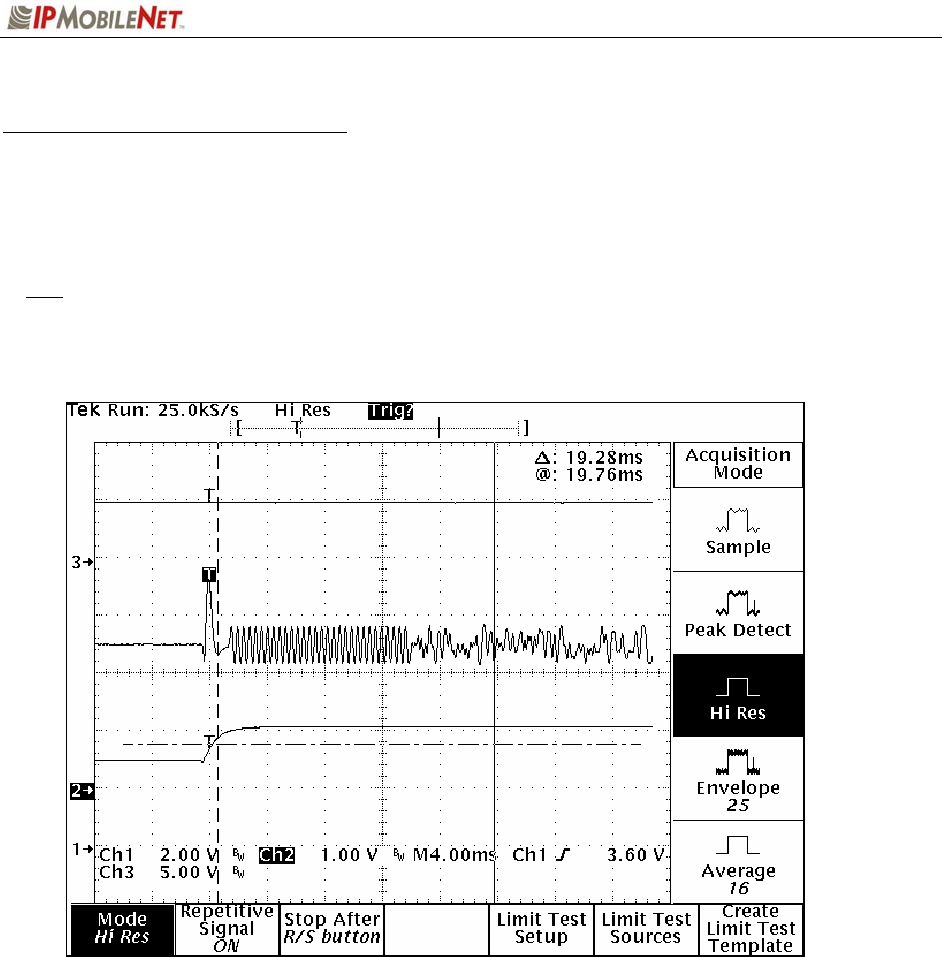
SECTION 4: FACTORY TEST PROCEDURE
M64700G25-FCCRpt.doc Page 33
Downlink Hardware Timing Verification
The figure below displays a plot of the downlink timing characteristics. Channel 1 is connected to RSSI,
channel 2 is connected to recovered audio, and channel 3 is connected to the modem CS pin. The scope
is in the high-resolution acquisition mode.
There is a very short period of quiet time (no modulation) followed by approximately 12 milliseconds of
modem synchronization time (sync time).
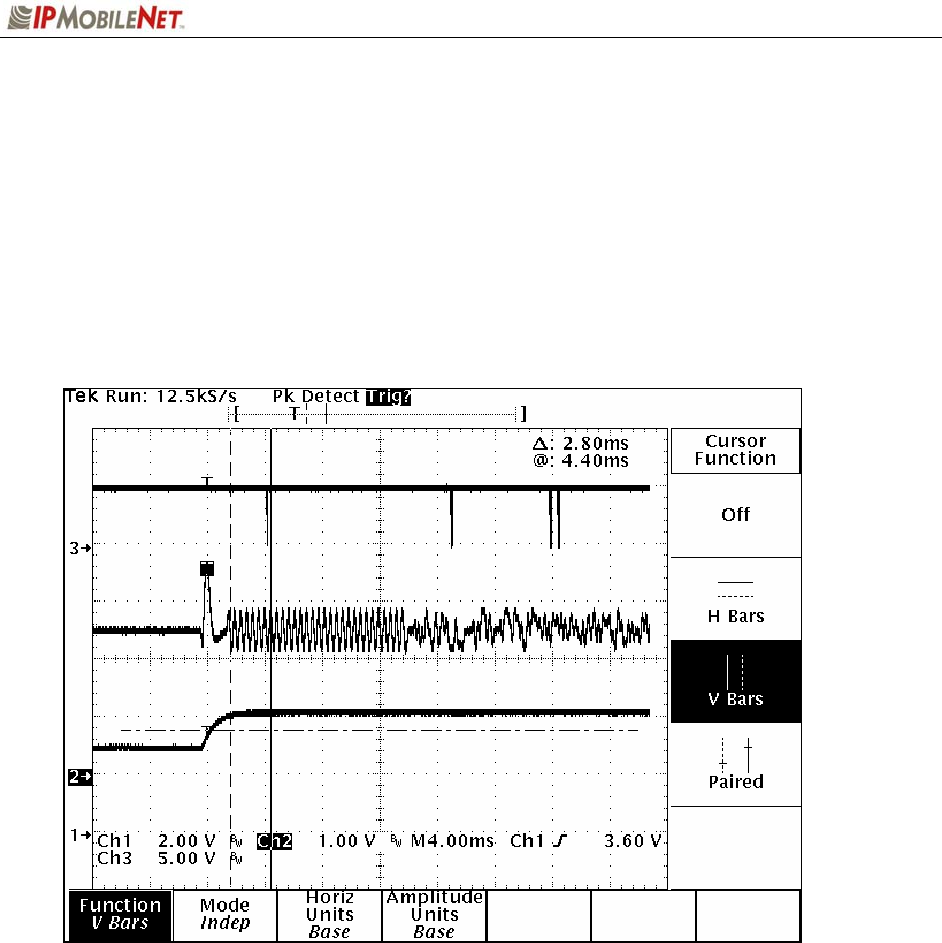
SECTION 4: FACTORY TEST PROCEDURE
M64700G25-FCCRpt.doc Page 34
The plot shown in the figure below is the same as before but now the scope is in the peak detect
acquisition mode. After the mobile radio detects a step response in the RSSI (caused by a down-link
transmission), the radio's microcontroller waits an amount of time equal to the programmed value of the
"carrier detect delay time" then instructs the modem to look for frame sync. When the microcontroller
instructs the modem to look for frame sync, it asserts the modem's CS line (active low). In this plot, the
modem's CS line can be seen to transition low approximately 3 milliseconds after the base station's
transmitter has come up to full power.
The recovered modulation should be centered at approximately 2.5 VDC and should have an amplitude
of approximately 800 mV peal-to-peak as indicated in the plot above.
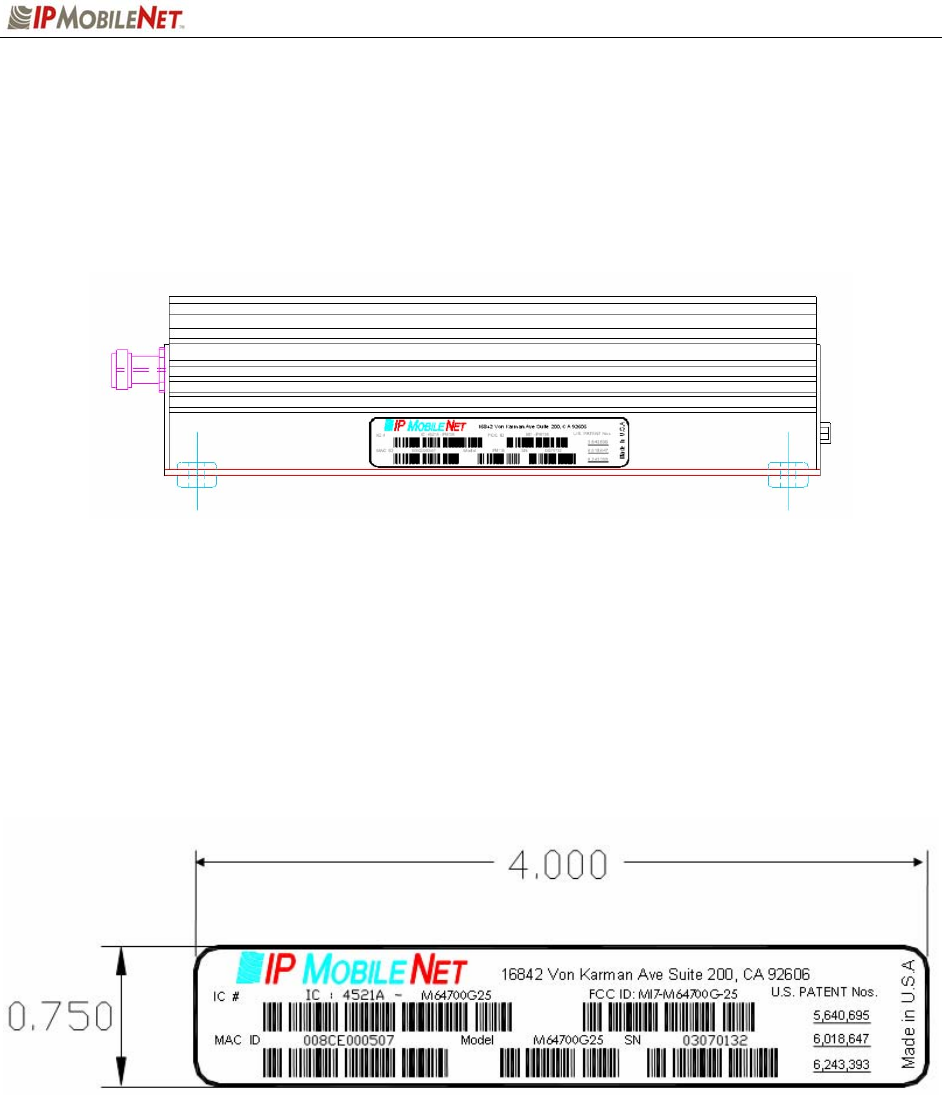
SECTION 5: FCC LABEL
M64700G25-FCCRpt.doc Page 35
M64700G25 Data Transceiver FCC Label Placement
M64700G25 Data Transceiver FCC Label
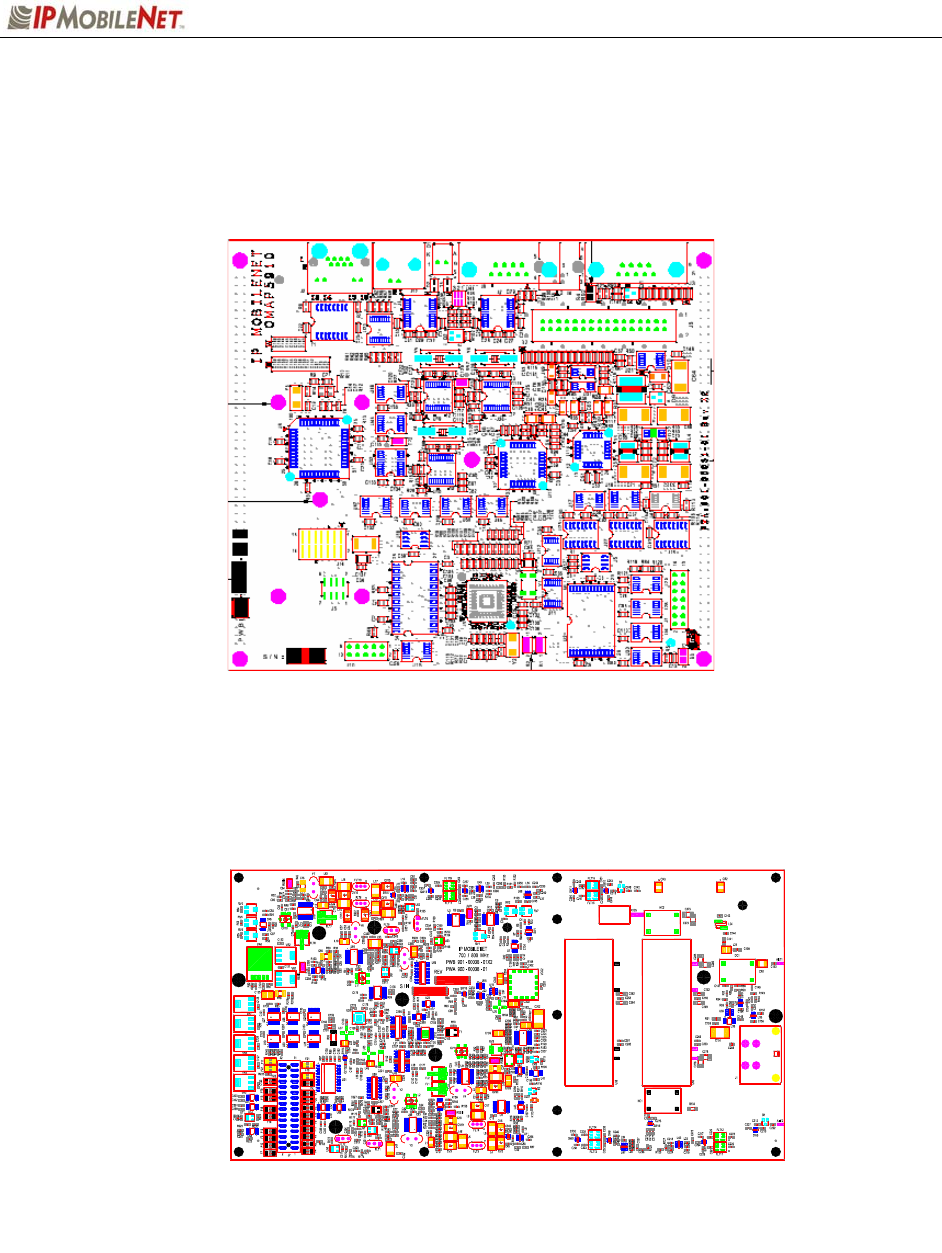
APPENDIX A: CIRCUIT BOARD DIAGRAMS
M64700G25-FCCRpt.doc Page 36
+
+
+
+
+
+
+
+
+
+
High Speed Mobile Radio OMAP 5910 Circuit Board
High Speed Mobile Radio RF Circuit Board

APPENDIX B: M64700G25 TEST DATA SHEET
M64700G25-FCCRpt.doc Page 37
Program and Configure Mobile Radio
Date
Serial Number
Firmware Revision
Tester
Adjustment / Alignment Procedures
Receiver Injection
Parameter Spec Measured
Injection Frequency Error at RXINJ1(within +/- 100
Hz of exact injection frequency) +/- 100 Hz
U17 pin 4 power level -3 to -5 dBm
Receiver 1& 2
Parameter Spec Receiver 1
Measured
Receiver 2
Measured
Audio DC Amplitude
(1 kHz Test tone @ 5.0 kHz
Deviation)
2.5 VDC
+/- 1mV
Audio AC Amplitude
(1 kHz Test tone @ 5.0 kHz
Deviation)
350 mVRMS
+/- 1mV
Distortion
(1 kHz Test tone @ 5.0 kHz
Deviation)
3%<
SINAD 12 dB
(1 kHz Test tone @ 5.0 kHz
Deviation)
-118dBm >

APPENDIX B: M64700G25 TEST DATA SHEET
M64700G25-FCCRpt.doc Page 38
Transmit Section
Parameter Spec Measured
Transmit Modulation Deviation
(4.9 kHz while transmitting 1400 character test message) 4.9 kHz
Transmit Data Quality
(While transmitting 1400 character test messages to the
base station)
240 >
Transmit Frequency Error
(Transmitting 1400 character test message) +/- 100Hz
Transmit Power Control
Caution: Do not to exceed 40-Watts RF output power during this test.
Transmit Power Setting Expected RF Out RF Out Watts
0 ~ 1mW
25
50
75
100
125
150
175
200
225
250
Parameter Digital Code Measure
Maximum power output setting without exceeding
40.0Watts

APPENDIX B: M64700G25 TEST DATA SHEET
M64700G25-FCCRpt.doc Page 39
Data Quality
Parameter
Spec Measured
Receiver 1 Data Quality
(While receiving 500 character “pings” from base station, 100 pings
min, no errors allowed, CRC errors enabled) 240>
Receiver 2 Data Quality
(While receiving 500 character “pings” from base station, 100 pings
min, no errors allowed, CRC errors enabled) 240>
Final Tests
Uplink Final
Parameter Spec Measured
Transmit Frequency Error
+/- 100 Hz
(Transmitting 19, 2000
character test message)
Transmit Modulation Deviation
4.9 kHz
(while transmitting 19,2000
character test message)
Uplink Hardware Timing Verified
Transmit Carrier ramp up time 2mS < X < 4mS
Symbol Sync time
(Stable Amplitude to with in 100mV during the period)
12ms +/- 1ms
Recovered modulation signal 1 V PtoP ~
2.5 VDC ~
Verify Sync Start
(RSSI to CS first going low)
10mS +/- 0.5
Verify Fram Sync (From end of Sync to CS second time going
low)
4 +/- 0.1 mS
Transmit Data Quality
(While transmitting 19, 1400 character test messages to the
base station)
240 >

APPENDIX B: M64700G25 TEST DATA SHEET
M64700G25-FCCRpt.doc Page 40
Downlink Final
Parameter Spec Measured
Downlink Hardware Timing Verification
Sync start
(RSSI to CS first going low) 3.0 +/- 0.5ms
Recovered Modulation Levels 800 mV~
2.5VDC~
Frame Sync
(From end of Sync to CS second time going low) 3.2 +/- 0.5 mS
Receiver 1 Data Quality
(While receiving 500 character "pings" from base station, 100 pings min, no
errors allowed, CRC errors enabled)
240>
LED Receiver 1 Lit
Receiver 2 Data Quality
(While receiving 500 character "pings" from base station, 100 pings min, no
errors allowed, CRC errors enabled)
240>
LED Receiver 2 Lit
Attach copy of all firmware settings Completed
Visual inspection Completed